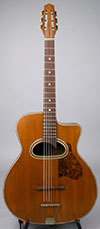1950s Di Mauro Boogie Woogie
Antoine Di Mauro was part of the mass emigration of master Sicilian luthiers (Busato, Oliveri Anastasio, etc) who left Catania in the early 20th century. In the 1930s Di Mauro and his countrymen setup a series of shops on the East side of Paris and quickly adapted their skills to making jazz guitars in the Selmer Maccaferri style. Di Mauro was certainly one of the most successful and long lasting of these Franco-Sicilian luthiers as his guitars were widely adopted by players of many styles. Di Mauro guitars were produced continuously until the early 90s, first by Antoine and then later by his son Joseph.
This Boogie Woogie model is Di Mauro's Maccaferri inspired instrument. It features a 12 fret neck, a 640mm scale, and a slightly larger 16 1/4" body. The top is spruce, the back sides are Cuban mahogany, the neck is mahogany, and the fingerboard is rosewood. The back binding is beech wood and the top binding is walnut which is decorated with 5 ply purfling. The Maccaferri inspired rosette features 14 black and white bands with a red center band. The trapeze tailpiece, tuners, and the celluloid pickguard are original.
The Boggie Woogie model has long been known as one of the best "pompe" (i.e. rhythm) guitars ever made for Gypsy jazz. The Di Mauro family were deeply in touch with the needs of professional Gypsy guitarists, allowing them to produce instruments which were perfectly suited for the aesthetics of this genre. This wonderful example is no exception as its look and sound transports you back to the mythical cafes and nightclubs of mid-century Paris. Best characterized as "bold" and "gutsy," this instrument's strength lies primarily in the punchy, clear midrange it produces. Chord hits crack like a whip while lush voicings ring full and clear. Additionally, the considerable age of this instrument has worked its magic, adding the character, definition, and clarity we've come to expect from well seasoned instruments.
The condition is excellent. The frets have just a slight bit of wear and there is one cleated top crack which is stable. The top looks rather clean for an instrument of this age. The back and sides show more wear, but nothing serious. Just some light scratches, finish checking, and dings. All in all, a very well preserved example.
This is the CASH price...add 3% if you'd like to pay with a credit card. Add 4% for international credit card orders.
 Di Mauro
Classic French guitar with good looks and a crisp tone!
Arts & Entertainment
di-mauro-boogie-woogie
Boogie Woogie
1800.00
DjangoBooks.com
https://www.djangobooks.com/Item/di-mauro-boogie-woogie
Di Mauro
Classic French guitar with good looks and a crisp tone!
Arts & Entertainment
di-mauro-boogie-woogie
Boogie Woogie
1800.00
DjangoBooks.com
https://www.djangobooks.com/Item/di-mauro-boogie-woogie
 Di Mauro
Classic French guitar with good looks and a crisp tone!
Arts & Entertainment
di-mauro-boogie-woogie
Boogie Woogie
1800.00
DjangoBooks.com
https://www.djangobooks.com/Item/di-mauro-boogie-woogie
Di Mauro
Classic French guitar with good looks and a crisp tone!
Arts & Entertainment
di-mauro-boogie-woogie
Boogie Woogie
1800.00
DjangoBooks.com
https://www.djangobooks.com/Item/di-mauro-boogie-woogie